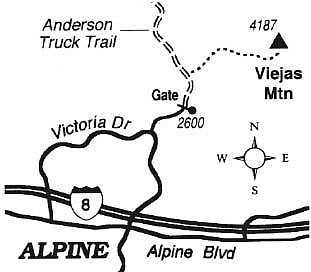 Facebook
Facebook
 X
X
 Instagram
Instagram
 TikTok
TikTok
 Youtube
Youtube
Standing apart from nearby peaks, Viejas Mountain can be seen from many parts of metropolitan San Diego as a dusky, obtusely triangular feature along the eastern horizon. A faint, partially overgrown trail up the west slope offers the only straightforward passage to the summit. The trek up this pathway is definitely tedious and unrewarding during hot or hazy weather, but it's well worth it on a cool, crystal-clear, late fall or winter day.
To reach the start of the trail, exit Interstate 8 at Tavern Road, go south 0.1 mile, then go east on Alpine Boulevard through the community of Alpine. After 1.5 miles, turn left (north) on East Victoria Drive, passing under I-8. Proceed 1.1 miles north to Anderson Road. Turn right and continue northeast 0.5 mile to a large water tank and gate (which could be closed, blocking motor traffic). Park just short of the gate and continue on foot 0.3 mile uphill to a point just before where the road becomes level. To your right (east) look for the unmarked beginning of the informal, 1.5-mile-long trail up the brushy slope of Viejas Mountain.
You'll be in waist- to shoulder-high chaparral the whole way, so wear long pants and sturdy shoes. On the way up, you get ever-broader views stretching all the way from Mexico to Orange County, with the San Diego County coastline and the blue Pacific Ocean in between. The broad valley to the east encompasses the Viejas Indian Reservation and its rapidly growing casino and shopping complex.
Years ago there existed on the summit of Viejas Mountain an arrangement of stones interpreted by anthropologists to be a winter-solstice marker, used for ceremonial purposes by the Kumeyaay Indians hundreds of years ago. The marker was a T-shaped array of stones that pointed precisely to a small peak on the southeastern horizon about 16 miles away. On topographic maps, this peak is identified as "Buckman" peak, elevation 4641 feet, located south of Pine Valley. Near winter solstice (December 19 through 23) the sun comes up directly behind this peak. Unfortunately, the marker was thoughtlessly destroyed by campers in the mid-1970s. In its place is a wall of stones built to serve as a windbreak.


Standing apart from nearby peaks, Viejas Mountain can be seen from many parts of metropolitan San Diego as a dusky, obtusely triangular feature along the eastern horizon. A faint, partially overgrown trail up the west slope offers the only straightforward passage to the summit. The trek up this pathway is definitely tedious and unrewarding during hot or hazy weather, but it's well worth it on a cool, crystal-clear, late fall or winter day.
To reach the start of the trail, exit Interstate 8 at Tavern Road, go south 0.1 mile, then go east on Alpine Boulevard through the community of Alpine. After 1.5 miles, turn left (north) on East Victoria Drive, passing under I-8. Proceed 1.1 miles north to Anderson Road. Turn right and continue northeast 0.5 mile to a large water tank and gate (which could be closed, blocking motor traffic). Park just short of the gate and continue on foot 0.3 mile uphill to a point just before where the road becomes level. To your right (east) look for the unmarked beginning of the informal, 1.5-mile-long trail up the brushy slope of Viejas Mountain.
You'll be in waist- to shoulder-high chaparral the whole way, so wear long pants and sturdy shoes. On the way up, you get ever-broader views stretching all the way from Mexico to Orange County, with the San Diego County coastline and the blue Pacific Ocean in between. The broad valley to the east encompasses the Viejas Indian Reservation and its rapidly growing casino and shopping complex.
Years ago there existed on the summit of Viejas Mountain an arrangement of stones interpreted by anthropologists to be a winter-solstice marker, used for ceremonial purposes by the Kumeyaay Indians hundreds of years ago. The marker was a T-shaped array of stones that pointed precisely to a small peak on the southeastern horizon about 16 miles away. On topographic maps, this peak is identified as "Buckman" peak, elevation 4641 feet, located south of Pine Valley. Near winter solstice (December 19 through 23) the sun comes up directly behind this peak. Unfortunately, the marker was thoughtlessly destroyed by campers in the mid-1970s. In its place is a wall of stones built to serve as a windbreak.
